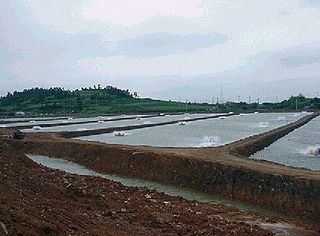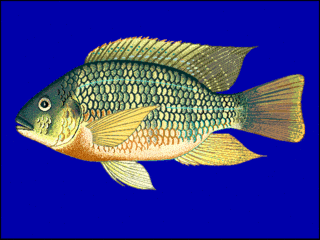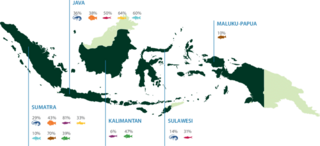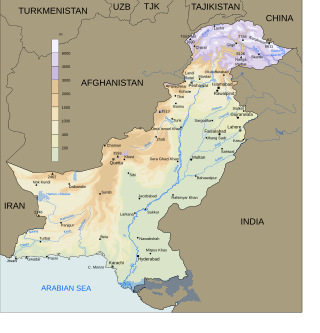
Aquaculture, also known as aquafarming, is the controlled cultivation ("farming") of aquatic organisms such as fish, crustaceans, mollusks, algae and other organisms of value such as aquatic plants. Aquaculture involves cultivating freshwater, brackish water and saltwater populations under controlled or semi-natural conditions, and can be contrasted with commercial fishing, which is the harvesting of wild fish. Mariculture, commonly known as marine farming, refers specifically to aquaculture practiced in seawater habitats and lagoons, as opposed to freshwater aquaculture. Pisciculture is a type of aquaculture that consists of fish farming to obtain fish products as food.

Mariculture or marine farming is a specialized branch of aquaculture involving the cultivation of marine organisms for food and other animal products, in enclosed sections of the open ocean, fish farms built on littoral waters, or in artificial tanks, ponds or raceways which are filled with seawater. An example of the latter is the farming of marine fish, including finfish and shellfish like prawns, or oysters and seaweed in saltwater ponds. Non-food products produced by mariculture include: fish meal, nutrient agar, jewellery, and cosmetics.

Fish farming or pisciculture involves commercial breeding of fish, most often for food, in fish tanks or artificial enclosures such as fish ponds. It is a particular type of aquaculture, which is the controlled cultivation and harvesting of aquatic animals such as fish, crustaceans, molluscs and so on, in natural or pseudo-natural environments. A facility that releases juvenile fish into the wild for recreational fishing or to supplement a species' natural numbers is generally referred to as a fish hatchery. Worldwide, the most important fish species produced in fish farming are carp, catfish, salmon and tilapia.

The Indian prawn is one of the major commercial prawn species of the world. It is found in the Indo-West Pacific from eastern and south-eastern Africa, through India, Malaysia and Indonesia to southern China and northern Australia. Adult shrimp grow to a length of about 22 cm (9 in) and live on the seabed to depths of about 90 m (300 ft). The early developmental stages take place in the sea before the larvae move into estuaries. They return to the sea as sub-adults.

Marine shrimp farming is an aquaculture business for the cultivation of marine shrimp or prawns for human consumption. Although traditional shrimp farming has been carried out in Asia for centuries, large-scale commercial shrimp farming began in the 1970s, and production grew steeply, particularly to match the market demands of the United States, Japan and Western Europe. The total global production of farmed shrimp reached more than 1.6 million tonnes in 2003, representing a value of nearly 9 billion U.S. dollars. About 75% of farmed shrimp is produced in Asia, in particular in China and Thailand. The other 25% is produced mainly in Latin America, where Brazil, Ecuador, and Mexico are the largest producers. The largest exporting nation is India.

A freshwater prawn farm is an aquaculture business designed to raise and produce freshwater prawns or shrimp for human consumption. Freshwater prawn farming shares many characteristics with, and many of the same problems as, marine shrimp farming. Unique problems are introduced by the developmental life cycle of the main species.

A fish hatchery is a place for artificial breeding, hatching, and rearing through the early life stages of animals—finfish and shellfish in particular. Hatcheries produce larval and juvenile fish, shellfish, and crustaceans, primarily to support the aquaculture industry where they are transferred to on-growing systems, such as fish farms, to reach harvest size. Some species that are commonly raised in hatcheries include Pacific oysters, shrimp, Indian prawns, salmon, tilapia and scallops.

Tilapia has become the third most important fish in aquaculture after carp and salmon; worldwide production exceeded 1.5 million metric tons in 2002 and increases annually. Because of their high protein content, large size, rapid growth, and palatability, a number of coptodonine and oreochromine cichlids—specifically, various species of Coptodon, Oreochromis, and Sarotherodon—are the focus of major aquaculture efforts.

Integrated multi-trophic aquaculture (IMTA) provides the byproducts, including waste, from one aquatic species as inputs for another. Farmers combine fed aquaculture with inorganic extractive and organic extractive aquaculture to create balanced systems for environment remediation (biomitigation), economic stability and social acceptability.

Aquaculture started to take off in New Zealand in the 1980s. It is dominated by mussels, oysters and salmon. In 2007, aquaculture generated about NZ$360 million in sales on an area of 7,700 hectares. $240 million was earned in exports.

Indonesia ranks as the fourth most productive country in the world measured in terms of gross yearly aquaculture production with an estimated 14.4 million tons in 2014. It benefits from being an archipelago nation with an extensive coastline over 81,000 km long, situated in a tropical climate. The top aquaculture products exported include shrimp, fish and seaweed.

The aquaculture of salmonids is the farming and harvesting of salmonid fish under controlled conditions for both commercial and recreational purposes. Salmonids, along with carp and tilapia, are the three most important fish groups in aquaculture. The most commonly commercially farmed salmonid is the Atlantic salmon.

China, with one-fifth of the world's population, accounts for two-thirds of the world's reported aquaculture production.

Fishery and fishing industry plays a significant part in the national economy of Pakistan. With a coastline of about 1,120 km, Pakistan has enough fishery resources that remain to be developed. Most of the population of the coastal areas of Sindh and Balochistan depends on fisheries for livelihood. It is also a major source of export earning.

Manufactured feeds are an important part of modern commercial aquaculture, providing the balanced nutrition needed by farmed fish. The feeds, in the form of granules or pellets, provide the nutrition in a stable and concentrated form, enabling the fish to feed efficiently and grow to their full potential.

Aquaculture is the farming of fish, shellfish or aquatic plants in either fresh or saltwater, or both. The farmed animals or plants are cared for under a controlled environment to ensure optimum growth, success and profit. When they have reached an appropriate size, they are harvested, processed, and shipped to markets to be sold. Aquaculture is practiced all over the world and is extremely popular in countries such as China, where population is high and fish is a staple part of their everyday diet.

South Korea is a major center of aquaculture production, and the world's third largest producer of farmed algae as of 2020.

Recirculating aquaculture systems (RAS) are used in home aquaria and for fish production where water exchange is limited and the use of biofiltration is required to reduce ammonia toxicity. Other types of filtration and environmental control are often also necessary to maintain clean water and provide a suitable habitat for fish. The main benefit of RAS is the ability to reduce the need for fresh, clean water while still maintaining a healthy environment for fish. To be operated economically commercial RAS must have high fish stocking densities, and many researchers are currently conducting studies to determine if RAS is a viable form of intensive aquaculture.

Aquaculture in the United Kingdom is dominated by salmon farming, then by mussel production with trout being the third most important enterprise. Aquaculture in the United Kingdom represents a significant business for the UK, producing over 200,000 tonnes of fish whilst earning over £700 million in 2012 (€793 million).
Biofloc technology (BT) is a fish farming system that recycles waste nutrients as fish food. Biofloc, specifically cultured microorganisms, are introduced into the water to form microbial protein from toxic fish waste and other organic matter. This maintains water quality as well as lowering costs. Candidate species must be resistant to environmental changes, tolerate high stocking density, adapt to changes in dissolved oxygen, and take microbial protein as food. BT is used in large-scale shrimp and finfish farms, mainly in Asia.






















